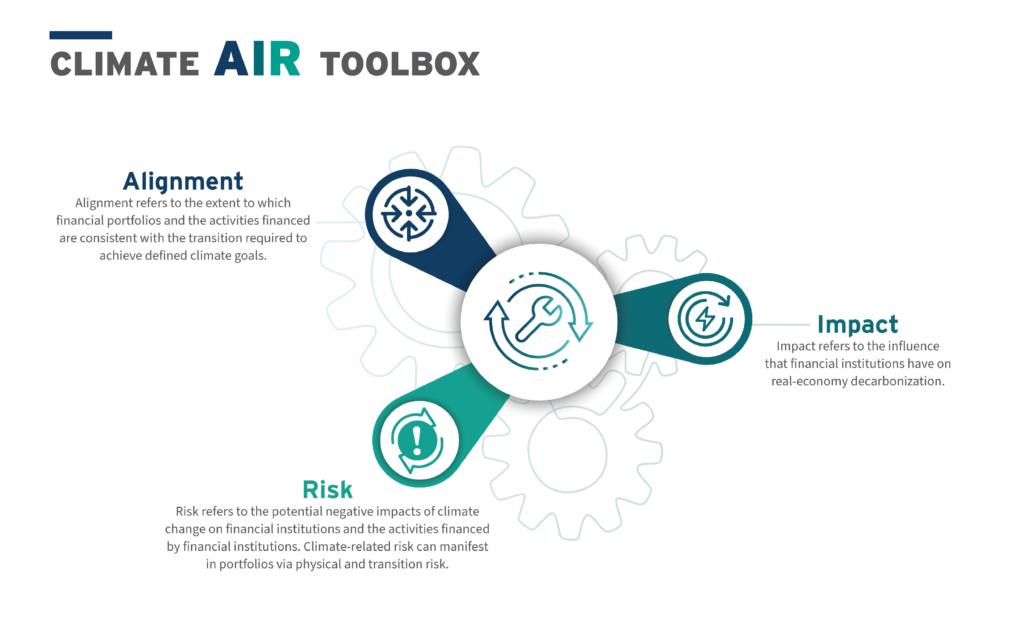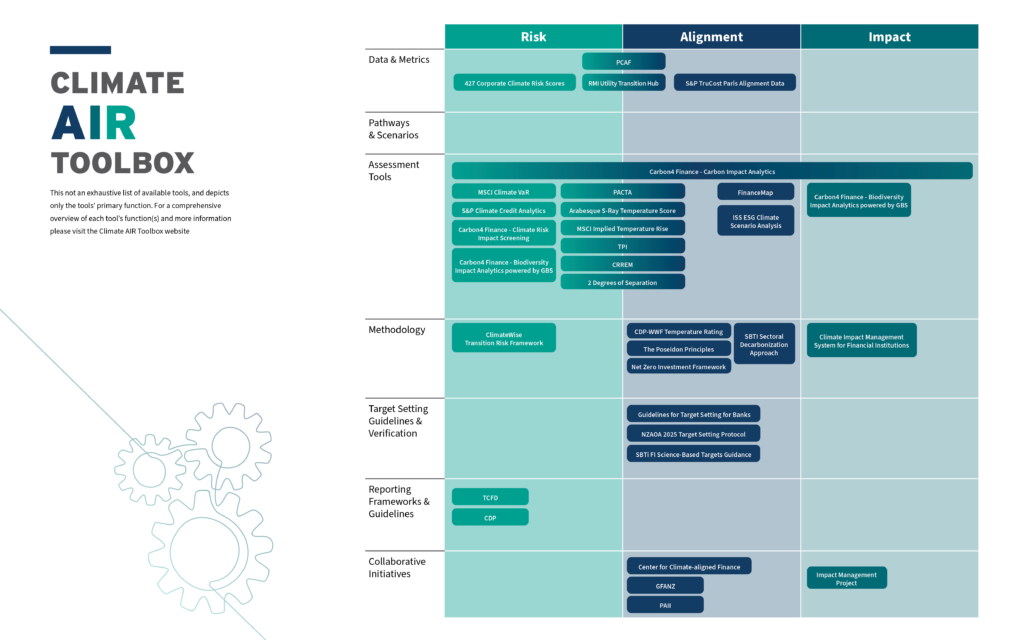green copper wind vane with bright sky, panoramic frame

Clearing the AIR: Introducing a Climate Alignment, Impact, and Risk Toolbox for Financial Institutions
As of July 2022, the Toolbox has been updated with approximately 20 new climate tools, to create a total of almost 50 tools to help financial institutions measure and report their real-economy impact.
—————–
A growing number of financial institutions have made net-zero commitments in the lead-up to COP26, the UN Climate Change Conference. On their own and through the various initiatives under the umbrella of the Glasgow Financial Alliance for Net Zero, these financial institutions are stepping up their climate ambition.
Yet once they make pledges, financial institutions often struggle to navigate the plethora of tools, frameworks, and platforms designed to help measure and manage an institution’s environmental footprint and evaluate progress against climate goals. Different tools do different things, are suitable for different types of financial institutions, and cover different asset classes and sectors.
To help financial institutions identify and understand the available open-source and proprietary options, RMI’s Center for Climate-Aligned Finance has developed a new overview and resource hub. This “Climate AIR Toolbox” can help financial institutions identify and access the relevant tools, frameworks, and platforms to measure and report their climate-related alignment, impact, and/or risk (AIR).
Navigating through the Climate AIR
To improve decision-making around the choice and use of climate-related tools and frameworks, financial institutions should first clarify their climate focus. Our toolbox highlights three distinct but overlapping foci: portfolio alignment, real-economy impact, and risk management.
These goals are not mutually exclusive, and financial institutions can pursue more than one at a time. For example, actions taken towards portfolio alignment can result in real-economy impact and risk reduction. However, it is important to distinguish between them, as achieving one will not necessarily lead to achieving others. For instance, measuring and managing climate risk will not directly lead to alignment with global climate goals, just as one firm’s achievement of portfolio alignment does not guarantee positive impact on real-economy decarbonization.
We define each focus in the following way:
- Portfolio alignment refers to the extent to which financial portfolios and the activities financed are consistent with the transition required to achieve defined climate goals.
- Real-economy impact refers to the influence that financial institutions have on real-economy decarbonization.
- Risk management refers to monitoring how climate change materially affects portfolio performance now and in the future. This can include climate-related physical risk (e.g., risks to physical assets and supply chains from more frequent or severe weather events like flooding, droughts and storms), transition risk (e.g., business risks associated with shifts towards a low-carbon world), and/or litigation risk (e.g., legal risks resulting from claims linked to physical or transition risks).
This framing demonstrates the ongoing shift in motivations for (and desired outcomes of) climate action. Measuring climate risk has been a core aspect of ESG and sustainable finance narratives for more than a decade, while the pursuit of portfolio alignment has emerged in the past year as financial institutions have increasingly set net-zero targets in line with the Paris Agreement. Financial institutions also face growing pressure from regulators, shareholders, and civil society to report on their climate-related impact, despite the persistent methodological challenges inherent in measuring the real-economy outcomes of their actions.
Clarity of focus can help financial institutions evaluate relevant climate actions and performance metrics. It can also help them determine which tools and resources will help them in their climate journey.
The Right Tool for the Job
The Climate AIR Toolbox features more than 30 tools and resources. This wide range of instruments and categories explains some of the confusion and complexity in the market when it comes to choosing which tools and frameworks to apply. To help financial institutions differentiate and choose among the relevant options, we categorize them into the following types of tools:
- Data & Metrics
- Pathways & Scenarios
- Assessment Tools
- Methodologies
- Target Setting Guidelines & Verification
- Reporting Frameworks & Guidelines
- Collaborative Initiatives
Some tools are very specialized, offering a certain type of support and analysis to a specific group of stakeholders, while others are more versatile and can be used to meet multiple needs. Further, sector and portfolio coverage of different providers varies, so firms may use several tools in tandem. By selecting the climate focus and the type of tool required, financial institutions can more easily identify the right tool for the job at any given stage of their journey. This landscape is summarized below in an illustrative graphic of tools’ primary functions.
Firms can also use the outputs and learnings from one part of the toolbox to enhance the reliability and usability of other tools as they progress in their climate journey. For instance, data gathered on financed emissions using the Partnership for Carbon Accounting Financials methodology can be used to set climate alignment targets in line with standards such as the Guidelines for Climate Target Setting for Banks, which were launched by the Net Zero Banking Alliance and backed by the UN Environment Programme. Both can be reported through the Task Force on Climate-Related Financial Disclosures framework.
Financial institutions can search the tools and learn more about their applicability and suitability by exploring short, standardized summaries of each tool.
An Expanding Toolbox
Our toolbox is not an exhaustive list of all tools and resources available, but it aims to centralize and standardize information about the growing number of products and services available to measure and manage financial institutions’ climate risk, alignment, and impact. We will periodically update our toolbox to reflect the ongoing development of available tools and resources.
Currently, financial institutions face a relative lack of tools and resources to help measure and report their real-economy impact. As firms face questions from clients, civil society, and regulators about greenwashing and how they will implement their climate commitments, financial institutions need ways to accurately and rigorously demonstrate how their actions support the net-zero transition. We hope to see more attention and innovation in this space, and look forward to adding further tools for measuring real-economy impact to the Climate AIR Toolbox.

